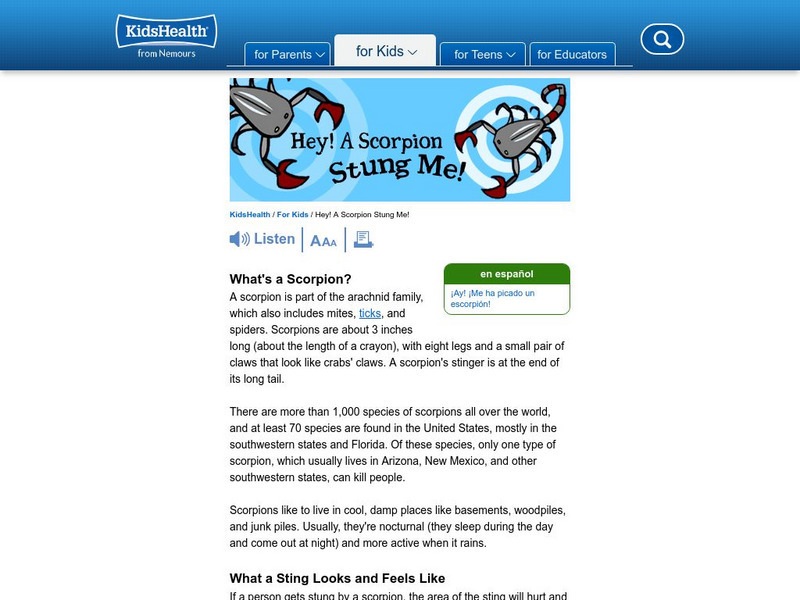Hi, what do you want to do?
Curated OER
Classification
Second graders sort insects into groups by determining similar characteristics. They role play as Entomologists to sort insects.
Curated OER
Spiders are Special
First graders recognize that spiders are important natural predators. They work in small groups with simple field guides to identify as many of their spiders as they can.
Curated OER
Arthropods
In this arthropods worksheet, learners review the characteristics of arthropods by choosing from 15 terms to fill in the blank of 10 statements.
Curated OER
Endangered Species
In this endangered species worksheet, students complete math word problems where they refer to the chart about endangered species. Students complete 7 problems.
Curated OER
Fearsome Creatures 2
In this fearsome creatures learning exercise, students choose the correct words to fill in the blanks to sentences about dangerous animals. Students complete this for 10 animals.
Curated OER
Invertebrates
In this invertebrates worksheet, learners read about the characteristics of the different groups of invertebrates. Then students complete 10 multiple choice questions.
Other
Harry's Big Adventure: Lesson Plans: Spider and Insect Detectives
Lesson plans that include group activities and handouts to introduce students to the differences between spiders and insects.
Akron Children's Hospital
Akron Children's Hospital: Kidshealth: Hey! A Tick Bit Me!
A tick attaches itself to the skin of a person or animal and sucks blood. Learn more about ticks in this article for kids.
Burke Museum
Burke Museum of Natural History and Culture: The Spider Myths Site
Are spiders insects? Do you really swallow spiders while you're sleeping? Myths and questions related to spiders are addressed on this site. Links to additional information can also be found here.
Ducksters
Ducksters: Bugs (Insects and Arachnids)
What is an instect? Kids learn about where and how bugs live. What is an arachnid?
My Learning
My Learning: Minibeasts
All you need for an in-depth study of invertebrates is here on this site. Includes worksheets, quiz, useful information, and a fun interactive section where you can build your own super bug!
Curated OER
Kids Health: Hey! A Chigger Bit Me
This site is provided for by Kids Health. Did you realize that chiggers are so small that they can actually be found on other bugs? They are a type of mite, which means they are an arachnid. What happens when you're bitten by a chigger?...
Curated OER
Kids Health: Hey! A Scorpion Bit Me
This site is provided for by Kids Health. Scorpions are nocturnal, which means they sleep mostly during the day and are active at night. Read about characteristics of scorpions, where they live, and what to do if you are stung by one.
Curated OER
Kids Health: Hey! A Tick Bit Me
This site is provided for by Kids Health. Learn more about ticks, the diseases they can carry, how to avoid them, and what to do if you are bitten by a tick. Watch a demonstration of how to remove a tick and what to do with it after...
University of Kentucky
University of Kentucky: Brown Recluse Spider
Webpage reference on the brown recluse spider which is more poisonous than a black widow and is more often found infesting homes and businesses.
Wikimedia
Wikipedia: Arthropod
Wikipedia offers information on arthropods, the largest phylum of animals. Includes scientific classification chart and image.
ClassFlow
Class Flow: Vertebrates and Invertebrates
[Free Registration/Login Required] Using this lesson the students will review the 2 groups of animals - vertebrates and invertebrates. They will be actively involved in classifying animals. An Activote assessment is also included.
Other
Natural Perspective: Joint Legs (Arthropoda)
A brief description of arthropoda and their population on the earth today. Som pictures of examples of the different classes of arthropods. (Includes insects, arachnids, crustacians, and malacostraca.)
Other
Walking Well: Arthropod Stings
This site has interesting information about stings from different arthropods like bees, wasps, hornets, yellow jackets, ants, caterpillars, spiders, ticks, centipedes, millipedes, and scorpions.
Science4Fun
Science4 Fun: Scorpion
Learn about the appearance, diet, habitat, conservation status, and other fun facts about this poisonous animal.
PBS
Pbs Teachers: Scientific American: Calls of the Wild: Spider Sounds
Explore the communication rituals of insects and other arachnids by constructing a device capable of detecting minuscule impacts of cricket feet.
HotChalk
Hot Chalk: Lesson Plans Page: Spooky Spiders
This simple lesson plan is designed to introduce young students to the characteristics of a spider and to classify whether a spider is an insect or an arachnid by analyzing its characteristics.
Regents of the University of Michigan
Animal Diversity Web: Phylum Arthropoda
This general overview of the arthropod phylum, which includes insects and arachnids, looks at such topics as body symmetry, appendages, movement, respiratory and nervous systems, and reproduction.
























